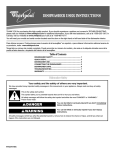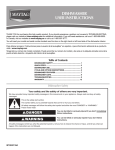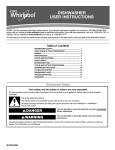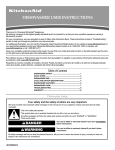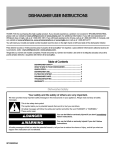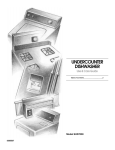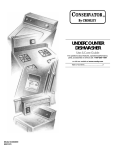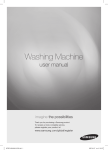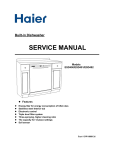Download Whirlpool Dishwasher (English)
Transcript
® DISHWASHER USER INSTRUCTIONS THANK YOU for purchasing this high-quality product. If you should experience a problem not covered in TROUBLESHOOTING, please visit our website at www.whirlpool.com for additional information. If you still need assistance, call us at 1-800-253-1301. In Canada, visit our website at www.whirlpool.ca or call us at 1-800-807-6777. You will need your model and serial number located near the door on the right-hand or left-hand side of the dishwasher interior. Para obtener acceso a “Instrucciones para el usuario de la lavavajillas” en español, o para obtener información adicional acerca de su producto, visite : www.whirlpool.com Tenga listo su número de modelo completo. Puede encontrar su número de modelo y de serie en la etiqueta ubicada cerca de la puerta al lado derecho o izquierdo del interior de la lavavajillas. Table of Contents DISHWASHER SAFETY ............................................................. 1 QUICK STEPS ............................................................................ 3 DISHWASHER USE.................................................................... 3 CONNECTING THE DISHWASHER .......................................... 5 DISHWASHER CARE ................................................................. 6 TROUBLESHOOTING ................................................................ 7 WARRANTY ................................................................................ 9 Dishwasher Safety Your safety and the safety of others are very important. We have provided many important safety messages in this manual and on your appliance. Always read and obey all safety messages. This is the safety alert symbol. This symbol alerts you to potential hazards that can kill or hurt you and others. All safety messages will follow the safety alert symbol and either the word “DANGER” or “WARNING.” These words mean: DANGER WARNING You can be killed or seriously injured if you don't immediately follow instructions. You can be killed or seriously injured if you don't follow instructions. All safety messages will tell you what the potential hazard is, tell you how to reduce the chance of injury, and tell you what can happen if the instructions are not followed. W10275146A IMPORTANT SAFETY INSTRUCTIONS WARNING: When using the dishwasher, follow basic precautions, including the following: ■ ■ ■ ■ ■ ■ ■ Read all instructions before using the dishwasher. Use the dishwasher only for its intended function. Use only detergents or rinse agents recommended for use in a dishwasher, and keep them out of the reach of children. When loading items to be washed: 1) Locate sharp items so that they are not likely to damage the door seal; and 2) Load sharp knives with the handles up to reduce the risk of cut-type injuries. Do not wash plastic items unless they are marked “dishwasher safe” or the equivalent. For plastic items not so marked, check the manufacturer's recommendations. Do not touch the heating element during or immediately after use. Do not operate the dishwasher unless all enclosure panels are properly in place. ■ ■ ■ ■ ■ Do not tamper with controls. Do not abuse, sit on, or stand on the door, lid, or dish racks of the dishwasher. To reduce the risk of injury, do not allow children to play in or on the dishwasher. Under certain conditions, hydrogen gas may be produced in a hot water system that has not been used for two weeks or more. HYDROGEN GAS IS EXPLOSIVE. If the hot water system has not been used for such a period, before using the dishwasher turn on all hot water faucets and let the water flow from each for several minutes. This will release any accumulated hydrogen gas. As the gas is flammable, do not smoke or use an open flame during this time. Remove the door or lid to the washing compartment when removing an old dishwasher from service or discarding it. SAVE THESE INSTRUCTIONS GROUNDING INSTRUCTIONS ■ For a grounded, cord-connected dishwasher: The dishwasher must be grounded. In the event of a malfunction or breakdown, grounding will reduce the risk of electric shock by providing a path of least resistance for electric current. The dishwasher is equipped with a cord having an equipment-grounding conductor and a grounding plug. The plug must be plugged into an appropriate outlet that is installed and grounded in accordance with all local codes and ordinances. WARNING: Improper connection of the equipmentgrounding conductor can result in a risk of electric shock. ■ Check with a qualified electrician or service representative if you are in doubt whether the dishwasher is properly grounded. Do not modify the plug provided with the dishwasher; if it will not fit the outlet, have a proper outlet installed by a qualified electrician. For a permanently connected dishwasher: The dishwasher must be connected to a grounded metal, permanent wiring system, or an equipment-grounding conductor must be run with the circuit conductors and connected to the equipment-grounding terminal or lead on the dishwasher. SAVE THESE INSTRUCTIONS WARNING Tip Over Hazard Do not use dishwasher until completely installed. Do not push down on open door. Doing so can result in serious injury or cuts. 2 Quick Steps 1 Prepare and load dishwasher. 3 Select a cycle and option (vary by model). 2 Add detergent for cleaning and rinse aid for drying. 4 Start dishwasher. Dishwasher Use ■ Make sure that when the dishwasher door is closed, no items are blocking the detergent dispenser. Prepare and Load the Dishwasher ■ IMPORTANT: Remove leftover food, bones, toothpicks and other hard items from the dishes. Remove labels from containers before washing. Items should be loaded with soiled surfaces facing down and inward to the spray as shown. This will improve cleaning and drying results. ■ Avoid overlapping items like bowls or plates that may trap food. 10 Place load pattern ■ Place plastics, small plates and glasses in the upper rack. Wash only plastic items marked “dishwasher safe.” ■ To avoid thumping/clattering noises during operation: Load dishes so they do not touch one another. Make sure lightweight load items are secured in the racks. ■ When loading silverware, always place sharp items pointing down. Mix other items pointing up and some pointing down. STEP 1 Upper rack Lower rack 12 Place load pattern (DP1040 model only) STEP 2 Add Detergent Upper rack ■ Lower rack Make sure nothing keeps spray arm(s) from spinning freely. It is important for the water spray to reach all soiled surfaces. ■ Use automatic dishwasher detergent only. Add powder, liquid or tablet detergent just before starting a cycle. ■ Fresh automatic A dishwasher detergent results in better cleaning. Store tightly B closed detergent container in a cool, dry place. Hard Water Soft Water MAIN WASH Hard Water Soft Water PREWASH C A. Cover latch B. Main Wash section C. Pre-Wash section 3 ■ The amount of detergent to use depends on: How much soil remains on the items - Heavily soiled loads require more detergent. The hardness of the water - If you use too little in hard water, dishes won't be clean. If you use too much in soft water, glassware will etch. Soft to Medium Water (0-6 grains per U.S. gallon) [typical water softener water and some city water] Medium to Hard Water (7-12 grains per U.S. gallon) [well water and some city water] ■ Depending on your water hardness, fill the Main Wash section of the dispenser as shown. Fill the Pre-Wash section to the level shown, if needed. NOTE: Fill amounts shown Hard Water are for standard powdered Hard Water Soft Water Soft Water detergent. Follow instructions on the package when using Main Wash Pre-Wash other dishwasher detergent. Add Rinse Aid ■ ■ Your dishwasher is designed to use rinse aid for good drying performance. Without rinse aid your dishes and dishwasher interior will have excessive moisture. The heat dry option will not perform as well without rinse aid. Rinse aid keeps water from forming droplets that can dry as spots or streaks. They also improve drying by allowing water to drain off of the dishes after the final rinse. Rinse aid helps to reduce excess moisture on the dish racks and interior of your dishwasher. ■ Check the rinse aid indicator. Add rinse aid when indicator drops to “Add” level. ■ To add rinse aid, turn the dispenser cap to “Open” and lift off. Pour rinse aid into the opening until the indicator level is at “Full.” Replace the dispenser cap and turn to “Lock.” Make sure cap is fully locked. Add Lock Refill Select Options (options vary by model) You can customize your cycles by pressing the options desired. Repeatedly press the button until the desired combination of options is selected. High Temp – (use only with Pots & Pans and Normal wash cycles) Heats the water during the wash portions of the cycle. Sani Rinse – (use only with Pots & Pans and Normal wash cycles) Select this option to raise the water temperature in the final rinse to approximately 155°F (68°C). Sani Rinse option adds heat and time to the cycle. This high temperature rinse sanitizes your dishes and glassware in accordance with NSF/ANSI Standard 184 for Residential Dishwashers. Certified residential dishwashers are not intended for licensed food establishments. wash cycles) Use for best drying results. When selected with the 1-hr Wash cycle, the time is increased by approximately 30 minutes. 4-hr Delay – (any cycle) Offers the choice to start the dishwasher automatically at a later time. Select a wash cycle and options. Press 4-hr Delay. Press START/RESUME. Close the door firmly. Lock – (on 4-hr Delay button) use to avoid unintended use of your dishwasher. When Control Lock is lit, all buttons are disabled. The dishwasher door can be opened while the controls are locked. To turn on Lock: Press and hold 4-hr Delay for at least 3 seconds. The Control Lock light glows. If you press any pad while your dishwasher is locked, the light flashes 3 times. Wash will clean the dishes using slightly more water and energy. Rinse Only – (no options apply to this cycle) Do not use detergent. This is only a rinse that keeps food from drying on your dishes and reduces odor buildup in your dishwasher until you are ready to wash a full load. Heated Dry – (use only with 1-hr Wash, Pots & Pans and Normal Full ■ 1-hr Wash – Use for lightly soiled items. For fast results, 1-hr To turn off Lock: Press and hold 4-hr Delay for at least 3 seconds. The Control Lock light turns off. ¹⁄₄ turn to lock Start or Resume a Cycle STEP 4 NOTE: For most water conditions, the factory setting of 2 will give good results. If you have hard water or notice rings or spots, try a higher setting. Turn the arrow adjuster inside the dispenser by either using your fingers or inserting a flat-blade screwdriver into the center of the arrow and turning. STEP 3 ■ Run hot water at the sink nearest your dishwasher until the water is hot. Turn off water. ■ Push door firmly closed. The door latches automatically. Select the wash cycle and options desired OR press START/RESUME to repeat the same cycle and options as in the previous wash cycle. ■ You can add an item anytime before the main wash starts. Open the door slowly and add the item. Close the door firmly. Press START/RESUME. ■ Clean indicator glows when the cycle is finished. Sanitized glows when Sani Rinse option is selected and sanitization levels occur. Select a Cycle (cycles vary by model) Press the Select Cycle button until the light below the desired cycle is on. NOTE: Heavier cycles and options affect cycle length. Some cycles and options will take up to 3¹⁄₂ hours to complete. Pots & Pans – Use for heavily soiled, hard-to-clean items. Normal – Use for normal food soil. The energy usage label is based on this cycle. Eco– Use for lightly soiled items. It saves energy. 4 Connecting the Dishwasher Portable Dishwashers (DP1040 model only) WARNING Electrical Shock Hazard Connecting the faucet adapter to faucets with external threads Insert the 2 screens and then the thin washer from the faucet adapter kit into the faucet adapter. Attach the adapter onto the end of the faucet. NOTE: Do not use the thick washer. Plug into a grounded 3 prong outlet. A B Do not remove ground prong. C Do not use an adapter. Do not use an extension cord. Failure to follow these instructions can result in death, fire, or electrical shock. Connecting the Faucet Adapter NOTE: A special adapter must be installed on the faucet before the dishwasher can be connected. Complete Installation Instructions and the adapter are packed with your dishwasher. (See the Installation Instructions.) When moving your dishwasher, make sure the door is latched. Hold the dishwasher at the top front corners. A. Thin washer B. Screens C. Faucet adapter Connecting the faucet adapter to faucets with internal threads Insert the 2 screens, the thin washer, and then the thick washer from the faucet adapter kit into the faucet adapter. Attach the adapter onto the end of the faucet. NOTE: Use both washers. Preparing the faucet A 1. Remove the screen holder or aerator, screen, and washer from the end of the faucet. 2. Use the faucet adapter kit that came with your portable dishwasher to modify the faucet where the dishwasher will be used. NOTE: Remove and save the washer, screen, and screen holder or aerator for future use. B C D A. Thick washer B. Thin washer C. Screens D. Faucet adapter Connecting to Water and Electrical Supply A B C A. Washer B. Screen C. Screen holder or aerator 1. Run water at the faucet until it is hot. Turn off the water. 2. Pull the hoses out of their storage compartment on the back of the dishwasher. NOTE: Make sure the hoses are not kinked or twisted. Kinked hoses reduce washing performance. 3. Pull down on the locking collar while lifting the hose connector onto the faucet adapter. A B C A. Faucet adapter B. Locking collar C. Hose connector 5 4. When the connector snaps into place, release the locking collar. 5. Turn the hot water on slowly until it is all the way on. 6. Plug into a grounded 3 prong outlet. 2. Press the red button on the connector to release the water pressure. A Disconnecting the Dishwasher B 1. Turn off the hot water. (This can be done after the last rinse.) C D A. B. C. D. Faucet adapter Locking collar Red button Hose connector 3. Lift slightly on the hose connector while pulling down the locking collar. Pull down on the connector. 4. Empty any remaining water from the connector by turning the connector upside-down. 5. Unplug the power supply cord and return it to the storage compartment. 6. Return the hoses to the storage compartment. Dishwasher Care Cleaning the Dishwasher Clean the exterior of the dishwasher with a soft, damp cloth and mild detergent. If your dishwasher has a stainless steel exterior, a stainless steel cleaner is recommended - Stainless Steel Cleaner and Polish Part Number 31462. Clean the interior of the dishwasher, with a paste of powdered dishwasher detergent and water or use liquid dishwasher detergent on a damp sponge to clean the cooled-down interior. A white vinegar rinse may remove white spots and film. Vinegar is an acid, and using it too often could damage your dishwasher. Put 2 cups (500 mL) white vinegar in a glass or dishwasher-safe measuring cup on the bottom rack. Run the dishwasher through a complete washing cycle using an air-dry or an energy-saving dry option. Do not use detergent. Vinegar will mix with the wash water. If you have a drain air gap, check and clean it if the dishwasher isn't draining well. Storing the Dishwasher If you will not be using the dishwasher during the summer months, turn off the water and power supply to the dishwasher. In the winter, if the dishwasher could be exposed to near freezing temperatures or is left in a seasonal dwelling such as a second home or vacation home, avoid water damage by having your dishwasher winterized by authorized service personnel. 6







